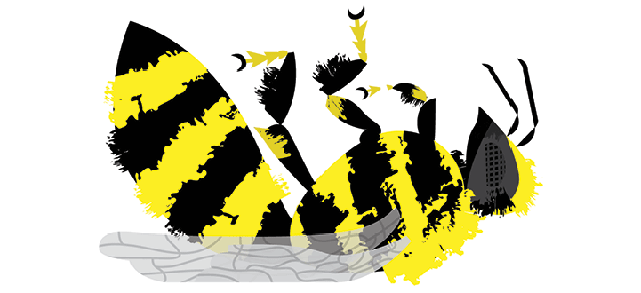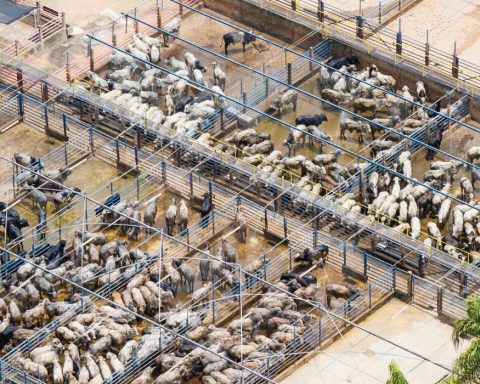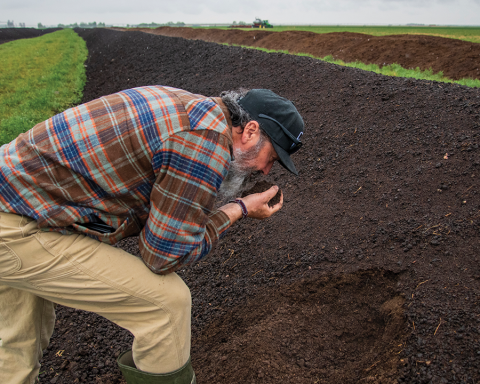Every year, the numbers heading to work in California’s central valley increase. In a pattern reminiscent of the mass migration illustrated in John Steinbeck’s The Grapes of Wrath, millions ride trains and buses to provide much-needed labour in the fertile valley. Only this time, it’s honey bees that are the labourers, sent to pollinate the massive almond crop that provides 85 per cent of global production.
About 1.5 million bee colonies – an estimated 60 per cent of the beekeeper-maintained domestic population – can now fetch up to $200 a hive for rental. The need to import over 30 billion honey bees from as far away as Florida has exposed the extent of modern agriculture’s dependence on the honey bee, and the food security dangers that lie in store as the worldwide pollination crisis unfolds.
More than 20,000 known species of bees serve as the lynchpin of a global pollination ecosystem that also includes hummingbirds, beetles, flies, moths and many others. “Every time we look deeper, we find the pollination system to be even larger and more complicated than our current models,” says bumblebee ecologist and conservation expert Dave Goulson. “The research is pretty nascent in this area, but it only points in one direction.”
The Food and Agriculture Organization of the United Nations has found 80 per cent of all flowering plant species and 35 per cent of worldwide crops to be reliant on these pollinators for reproduction. A team of researchers from four German universities recently estimated the value of ecological pollination services at approximately €265 billion (US$360 billion) a year.
Although researchers and ecologists have long warned about the mounting threats challenging pollinators across the globe, the emergence of colony collapse disorder (CCD) has focused research efforts and media attention on the problem. In 2006, honey bee populations in Europe and North America began dying off at a much greater rate than before. Unlike previous spells in apicultural (beekeeping) history, it has shown no signs of subsiding.
“We’ve been facing a general decline in bee populations, around 30 per cent or higher for the past seven years,” says Canadian Association of Professional Apiculturists president Rheal Lafreniere. “There’s little doubt that it has to do with their health.”
Researchers agree that a confluence of factors is driving honey bee deaths, while also serving to weaken the remaining population. For University of Maryland entomologist Dennis vanEngelsdorp, establishing causality remains a work in progress. “We know that it involves the parasitic varroa mite, poor bee nutrition, and there is increasing evidence in the U.S. that more and more land in the Midwest is being ploughed under by corn and soybean, with more exposure to pesticides,” he says.
The spread of viruses and parasitic mites has steadily accelerated as bees are brought together from different areas of the globe. Strict regulations ban bee exports and imports along the Canadian border, but bees from Michigan mingling with bees from Florida results in a mass exchange of parasites. The Asian varroa mite has proven to be particularly deadly, spreading from Indonesia to every continent but Australia. The International Centre of Insect Physiology and Ecology, based in Nairobi, has uncovered a number of European diseases in Kenyan bees.
Pesticides – particularly those that contain neonicotinoids – are also being linked to the spread of CCD. Various studies have linked a weakening of the immune systems for bees with pesticide exposure, which in turn makes them more susceptible to viruses and mites. Research from USDA scientist Jeff Pettis found 35 different pesticides in bee pollen tests conducted in 2013. Fungicides, previously viewed as harmless to bees, were also implicated in a study last year led by vanEngelsdorp. Healthy bees fed pollen containing fungicide increased their chances of infection by 300 per cent.
Invasive plants continue to crowd out native plants previously served by bees and other pollinators, while invasive species such as the Chinese hornet have spread into Spain, Portugal and Belgium after originally arriving on a boat in France. A single hornet can kill up to 40 bees a minute. The ongoing loss of diverse land to monoculture eliminates bee habitat, while climate change threatens to decouple the timing of the bees’ emergence in the spring with the germination of flowers and plants.
Governments have grown progressively more worried about CCD because it imperils the only manner of pollination for hundreds of crops used to feed their populations. With global food supplies expanding to feed growing numbers, the pivotal role that bees play in agriculture is set to grow ever larger. Although beekeepers have thus far been able to keep population levels steady through increased breeding and other techniques such as hive-splitting, this has boosted costs dramatically. American prices for bees have risen as much as 20 per cent over the past several years, with costs skyrocketing for massive operations such as the California almond crop.
The honey bee is native to Europe, Asia and Africa, with various sub-species located in each continent. British settlers in North America introduced them as early as 1622 in an attempt to pollinate non-native crops. As the bee is not native to the Americas and Australia, it is only used there for agricultural purposes.
For Dave Goulson, concerns over food safety form one part of a broader ecological catastrophe if pollinators in the wild continue to die off. In an effort to sound the alarm, he penned a column in the Financial Times in November titled “There is no Plan Bee for when we run out of pollinators.”
“European honey bees are remarkably resilient creatures, so the fact that they are dying off at greater rates does not bode well for the other, more vulnerable bee species,” states Goulson. Efforts to measure the health of bees and other pollinators tasked with maintaining the native biodiversity of each landmass have proven difficult compared to the relatively simple task of gathering data from beekeepers about honey bees.
A study published in the journal Science last year compared records compiled by 19th century American entomologist Charles Robertson with 1970-71 and 2009-10 data on domestic bee populations. The researchers from the University of Montana found that more than half of American bee species had gone extinct in the past 120 years. The surviving species had seen their own ability to pollinate specific plants vastly reduced.
Addressing these problems will require, in part, stronger research and coordination by governments, academia and the private sector. Some encouraging signs are emerging, with the European Union increasing funding into bee research in Europe. It has also teamed up with the United Nations Environment Programme to establish the European Week of Bees and Pollination. Plans to invest €13 million to protect bee health in Africa are in the works. The Canadian pollination research network Canpolin, meanwhile, raised $10 million by pairing federal government research funding with industry grants.
Beekeepers remain at the forefront of innovation, teaming up with scientists to introduce new technologies to help monitor and maintain bee health. A new company has even introduced an open source sensory kit for bee hives that transmits health data to an open data platform. Apiculturists and entomologists such as vanEngelsdorp have begun to push for added incentives to make beekeeping both more profitable and popular among the general population.
For Simon Fraser University professor Elizabeth Elle, expanding bee forage territory is one of the simplest options available. An expert in the impact of human activities on pollinator diversity, she explained at the Canpolin gathering in Guelph, Ontario, this past fall that agricultural communities practising monoculture need to become more hospitable to bees.
Efforts to regulate pesticide use to address CCD have met considerable opposition. The European Parliament was the first body to pass a two-year moratorium on three types of neonicotinoids last April. European companies Bayer and Syngenta, two manufacturers of the pesticides, fiercely opposed the plan in court but failed to overturn the legislation.
A number of environmental groups are suing the U.S. Environmental Protection Agency over its perceived failure to regulate neonicotinoids, while the state of Oregon announced the temporary ban of a particular pesticide after a rash of bee deaths were reported. Health Canada’s Pest Management Regulatory Agency has also proposed new rules surrounding the use of neonicotinoids. Soy and corn farmers will be required to alter planting practices to reduce dust during planting, while new warning labels on seeds mixed with pesticides will be introduced.
Attempting to head off the neonicotinoid ban, Syngenta and Bayer proposed an alternative action plan in March 2013 to unlock the EU stalemate on bee health. It even included an outline to “significantly scale up the creation of pollen rich, flowering field margins across the EU to provide essential habitat and nutrition for bees.”
At least everyone is in agreement that we have a problem. It’s a beginning.







